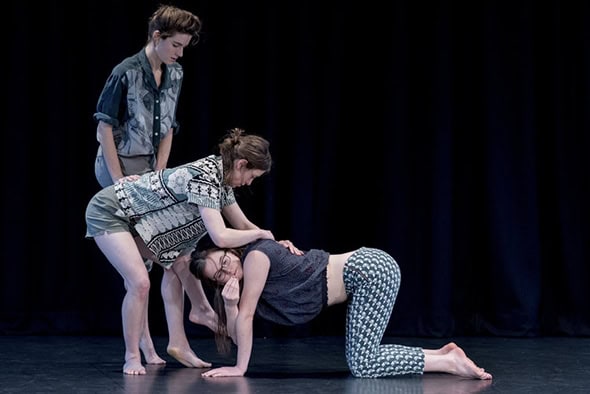Nora invites Deborah Hay – Where Home Is
Posted: May 2nd, 2019 | Author: Ian Abbott | Filed under: Performance | Tags: Deborah Hay, Eleanor Sikorski, Flora Wellesley-Wesley, Nora, Nora Invites, Playing Dance, Probe, Stephanie McMann, Where Home Is | Comments Off on Nora invites Deborah Hay – Where Home IsNora invites Deborah Hay – Where Home Is, Lilian Baylis Theatre, April 25

“One never reaches home,’ she said. ‘But where paths that have an affinity for each other intersect, the whole world looks like home, for a time.” – Herman Hesse
Nora is dancers Eleanor Sikorski, Flora Wellesley Wesley and Stephanie McMann. Sikorski and Wellesley Wesley were previously a duo who in 2015 invited Liz Aggiss, Simon Tanguy, Jonathan Burrows and Matteo Fargion to make an evening of duets for them. With the addition of McMann their performance, staging and presence has shifted entirely. McMann has worked with a number of choreographers including Roberta Jean and Theo Clinkard; she has a beguiling and luminous presence that draws attention. The two bodies of Sikorski and Wellesley Wesley have a clear relationship with their previous invitees; with the trio on stage the reading becomes a little trickier. They define themselves as a dancer-led company; I get a sense they are collectors of a certain type of choreographer whose work has a conceptual pedigree but that is not averse to niche mass appeal. In November 2018 Nora worked with Deborah Hay to create a performance entitled Where Home Is which forms the first part of the evening followed by Playing Audience, a short conversational invitation to the audience to reconsider how we experience dance.
Hay is a scrambler, an unsettler, a not-dancer, a re-framer and Nora revel in her environment. In the thirty-five minutes of Where Home Is there is acres of attentional space for an audience to approach the work, be with it, ignore it, drift elsewhere or come back; it will give you what you give to it, but you have to give first. Located closer to choreographic performance art, Hay doesn’t often treat Nora as a trio but more like three ones with the odd two plus one; the interconnectedness and relational quality of the three isn’t present. Our visual grid is populated by solo components; we have buckets of almost still poses, Sikorski’s presentational arches, McMann’s faux cockney encouragement and Wellesley Wesley’s scenographic inspections. There are moments that face outward with Sikorski and McMann almost goading Wellesley Wesley with false hyperbole and exaggerated encouragement as she attempts to execute a series of stuttering classical moves and travelling sequences. This three-minute interjection offers an alternative emotional palette and a chance for the audience to laugh, release and enjoy.
The notion of home is an interesting one; these three dancing bodies are now a temporary home for Hay’s score. They are respectful and practiced guardians of the work, keeping it inside and between them. Nora is home and Nora is together thanks in part to a three-week period prior to the premiere working with rehearsal support from Rachel Krische who was herself a receiver of a Deborah Hay solo, The Swimmer, over 10 years ago.
There are echoes of early Probe where two exceptional dancers — Antonia Grove and Theo Clinkard — invited choreographers including Lea Anderson, Rafael Bonachela, Yasmeen Godder and Trisha Brown to make work on them in Have We Met Somewhere Before (2005) and Magpie (2008). Over three years Probe collected 11 choreographers who made them look exquisite, squeezing the juice out of their technique and their relationship as a duo. They allowed space for themselves, their choreographic collective as well as for the audience.
Playing Dance lasted for 20 minutes with each performer asking a question which might reframe how the audience receives the work: “What if, as audience, I remember to recognise time is passing? Time is not fixed.” Playing Dance became part of the evening because when Hay was making the work with Nora in Nottingham she would spend the mornings with the trio and each afternoon rehearsing her own solo work, leaving Nora to look at, reframe and process the choreographic questioning of Hay’s What ifs.
Where Home Is is a score that is practiced and it would be the same with or without our presence; this was reiterated after the pause during Playing Dance where the audience is told “This is not feedback for us, we don’t care, this is a space for a you.” An audience is already the guest of the presenting artist; individuals come to the theatre having purchased tickets and give their attention in exchange. Nora’s exchange ratio of performer to audience this evening is around 1 to 55, so we received 1/55 of a transmitted Deborah Hay and I left wanting more. Nora invites Deborah Hay but Nora does not invite the audience.